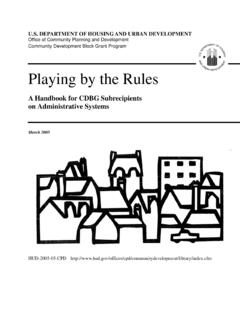Transcription of Best Practices Guide: Fundamentals of a Workplace First ...
1 Best Practices Guide: Fundamentals of a Workplace First -Aid Program OSHA 3317-06N 2006. This best Practices guide is not a standard or regulation, and it creates no new legal obligations, nor does it change any existing OSHA standard or regulation. The guide is advisory in nature, infor- mational in content, and is intended to assist employers in providing a safe and healthful Workplace . The Occupational Safety and Health Act of 1970. (OSH Act) requires employers to comply with hazard-specific safety and health standards and regulations as issued and enforced by either the Federal Occupational Safety and Health Administration (OSHA), or an OSHA-approved State Plan.
2 In addition, employers must provide their employees with a Workplace free from recognized hazards likely to cause death or serious physical harm under Section 5(a)(1), the General Duty Clause of the Act. Employers can be cited for violating the General Duty Clause if there is a recognized hazard and they do not take steps to prevent or abate the hazard. However, failure to implement this guide is not, in itself, a violation of the General Duty Clause. Citations can only be based on standards, regulations, and the General Duty Clause. Best Practices Guide: Fundamentals of a Workplace First -Aid Program Department of Labor Occupational Safety and Health Administration OSHA 3317-06N.
3 2006. Contents Introduction and Purpose .. 3. The Risks: Injuries, Illnesses and Fatalities .. 4. Assess the Risks and Design a First -Aid Program Specific for the Worksite .. 5. OSHA Requirements .. 8. First -Aid Supplies .. 9. Automated External Defibrillators .. 10. First -Aid Courses .. 11. Elements of a First -Aid training Program .. 11. Trainee Assessment .. 15. Skills Update .. 15. Program Update .. 15. Summary .. 16. Additional Resources on First Aid, CPR. and AEDs .. 16. References .. 17. OSHA Assistance .. 18. OSHA Regional Offices .. 23. 2. Introduction and Purpose First aid is emergency care provided for injury or sudden illness before emergency medical treatment is available.
4 The First -aid provider in the Workplace is someone who is trained in the delivery of initial medical emergency procedures, using a limited amount of equipment to perform a primary assessment and intervention while awaiting arrival of emergency medical service (EMS). personnel. A Workplace First -aid program is part of a comprehensive safety and health management system that includes the following four essential elements 1: Management Leadership and Employee Involvement Worksite Analysis Hazard Prevention and Control Safety and Health training The purpose of this guide is to present a summary of the basic elements for a First -aid program at the Workplace .
5 Those elements include: Identifying and assessing the Workplace risks that have potential to cause worker injury or illness. designing and implementing a Workplace First -aid program that: Aims to minimize the outcome of accidents or exposures Complies with OSHA requirements relating to First aid Includes sufficient quantities of appropriate and readily accessible First -aid supplies and First -aid equipment, such as bandages and automated external defibrillators. Assigns and trains First -aid providers who: receive First -aid training suitable to the specific Workplace receive periodic refresher courses on First -aid skills and knowledge.
6 1. CSP 03-01-002 - TED - Voluntary Protection programs (VPP): Policies and Procedures Manual Notice. 54 Federal Register 3904-3916. Available at =2976. 3. Instructing all workers about the First -aid program, including what workers should do if a coworker is injured or ill. Putting the policies and program in writing is recommended to implement this and other program elements. Providing for scheduled evaluation and changing of the First -aid program to keep the program current and applicable to emerging risks in the Workplace , including regular assessment of the adequacy of the First -aid training course. This guide also includes an outline of the essential elements of safe and effective First -aid training for the Workplace as guidance to institutions teaching First -aid courses and to the consumers of these courses.
7 The Risks: Injuries, Illnesses and Fatalities There were 5,703 work-related fatalities in private industry in 2004. In that same year there were million total Workplace injuries and illnesses, of which million resulted in days away from work. Occupational illnesses, injuries and fatalities in 2004 cost the United States' economy $ billion, according to National Safety Council estimates. The average cost per occupational fatality in 2004 exceeded one million dollars. To cover the costs to employers from Workplace injuries, it has been calculated that each and every employee in this country would have had to generate $1,010 in revenue in Sudden cardiac arrest (SCA) may occur at work.
8 According to recent statistics from the American Heart Association, there are 250,000 out-of-hospital SCAs annually. The actual number of SCAs that happen at work are unknown. If an employee collapses without warning and is not attended to promptly and effectively, the employee may die. Sudden cardiac arrest is caused by abnormal, uncoordinated beating of the heart or loss of the heartbeat altogether, usually as a result of a heart attack. 2. National Safety Council. (2006). Injury Facts, 2004 - 2006 Edition. Itasca, IL, p. 51. 4. Workplace events such as electrocution or exposure to low oxygen environments can lead to SCA.
9 Overexertion at work can also trigger SCA in those with underlying heart disease. The outcome of occupational illnesses and injuries depends on the severity of the injury, available First -aid care and medical treatment. Prompt, properly administered First aid may mean the difference between rapid or prolonged recovery, temporary or permanent disability, and even life or death. Assess the Risks and Design a First -Aid Program Specific for the Worksite Obtaining and evaluating information about the injuries, illnesses and fatalities at a worksite are essential First steps in planning a First -aid program. Employers can use the OSHA 300 log, OSHA.
10 301 forms, their Workers' Compensation insurance carrier reports or other records to help identify the First -aid needs for their businesses. For risk assessment purposes, national data for injuries, illnesses and fatalities may be obtained from the Bureau of Labor Statistics (BLS) website at The annual data, beginning in 2003, are grouped by the North American Industrial Classification System (NAICS) that assigns a numeric code for each type of work establishment. Prior to 2003, the Standard Industrial Classification (SIC) system was used to categorize the data instead of NAICS. The graphs that follow provide examples of fatality, injury and illness analyses that can be developed using BLS data.













